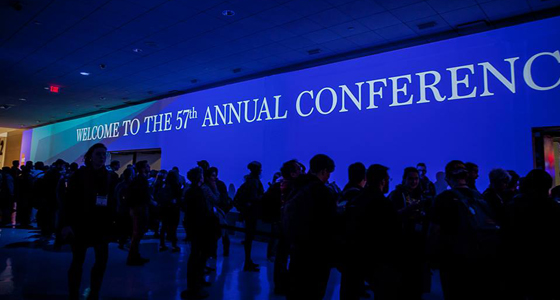Yale grad student Wladimiro A. Woyno R. brought projection magic to USITT 2017 serving as media content and on-site production manager for the Stage Expo entrance structure and experience. The 136′ seamless video projection wall created a striking and inspiring first impression for the 5,500+ attendees in St. Louis.
Tell me about your educational background and design experience?
I’m originally from Columbia and I did my undergrad at University of British Columbia with a BFA in theatre design and production with a focus on set lighting and projection design. After that I worked a lot on contemporary dance and contemporary theatre as a designer and technologist. Currently I’m doing my masters in projection design at the Yale School of Drama. I’m in my second year and it’s been pretty rad!
How did the idea for the projection wall come about?
USITT was looking for a way to make the lobby a more welcoming experience for the Expo. They were discussing some different graphics or big posters they could do. Ron Procopio, USITT Expo Director, had seen a display that was video, and said “what if we try it with video?” That’s when they contacted me through Erich Bolton, Assistant Professor (Adjunct) & Projection Supervisor at Yale university. We started talking about whether was it possible to do a big video wall installation instead of just a printed graphic or something like that. I said “Yeah, that sounds fun and interesting…I think we should try that.” I started to look into what equipment we could get donated and what system we would need to accomplish it and then just go for it.
Explain the process of creating and installing the video wall?
I started by calculating how large an area we were going to project on. We arrived at 140 ft. by 11.5-12 ft. We then looked at how many projectors we would need, how many computers, and what kind of processing we would need. The system ran on seven projectors on six computers using Dataton’s Watchout-a high-end media system that can deliver multi-projector installation and can load content. The biggest challenge was trying to figure out how to put all of these pieces together. I talked to Marty Karp from Show Sage (distributors of Watchout) and mentioned that we were looking at edge blending seven projectors across a surface. They provided the computer and software licenses. Epson provided seven 7,000 lumen high HD projectors and that was great!
Gerriets International provided the screen material. It was a single piece of fabric across the entire width, which is an impressive sight. In an incredibly nerve-wracking moment, they custom cut the fabric while in place to accommodate the doors, to avoid having seams. XS Lighting provided the trussing. Once that was figured out my job was to calculate the overlap of the projectors and build special effects patterns to be able to properly overlap the projectors. Most content gets created in HD resolution at 1920 px by 1080 px. This was seven times that at 11,040 px by 1080 px.
Who provided the images?
I wanted to do something that had motion that could be in large chunks and could essentially take over the entire wall. My work on the wall, separate from the technical exploration was the motion graphics for USITT. I used a video glitch piece called Depth Charge which was developed using Roberto D. Jordan’s Video Equations video synthesizer, filming an analog tv and processing in after-effects. The piece with the rose and clouds was from Yaara Bar, a first-year projection designer at the Yale school of Drama, called T/T/T . The piece with the shiny spinning jewels is called Experiments in Movement by Matthew Waddel, a sound and projection designer based in Montreal. The content with the red drape and different backdrops and the wide shot of St. Louis was provided by Silver Stage Productions and BMD (Broadway Media Distribution).
Were there any challenges that you faced?
One of the big challenges is you how you project on the wall without getting everyone’s shadows in the way. The trick there is to put the projectors up as high as you can. The hallway was 13 feet so we asked for truss that would put the projectors at 12 feet.
The biggest difficulty was in getting the equipment delivered. Instead of arriving on Saturday, it arrived on Wednesday morning so the time crunch was intimidating. At first, I was stressed but then I thought “Okay, now people will get to watch the process and how you do something like this.” People were walking by as we were installing the projectors and truss patterns, lining the projectors, and starting to edge blend. I think it worked out nicely. It was kind of like a masterclass; people could see how you’re able to install something that large.
What feedback did you receive?
The wall had quite a positive reaction! I think people were not expecting something of that scope. Overall it was a positive response.
USITT’s Executive Director, David Grindle, talks about USITT’s video wall and its specs.
